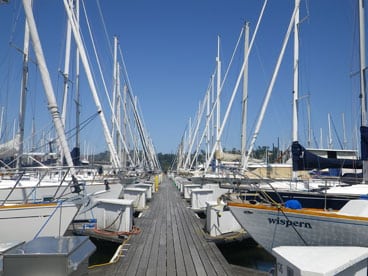
Passage Notes October
When the landlubbers of Marin County, California, aren’t expressing themselves through free dance, they’re likely sipping Napa varietals or hauling themselves up Mount Tamalpais on sleek two-wheelers. Not so the sailors of the waterfront. They steadfastly stick to their own devices, far more into chainplates than chardonnay.
One liveaboard community in particular, on the periphery of the charming city of Sausalito, north of the Golden Gate Bridge, has seemingly little to do with the bunch inhabiting the hills around them. Yet from what I could tell during a brief stopover in the spring of 2011 before the Strictly Sail Pacific boat show in Oakland, on the other side of San Francisco Bay, this zany little tribe is hardly worse for the wear.
Against an attractive shoreline dotted with sailboats, powerboats, and houseboats at once funky and tasteful, they take leashed kitties for walks in baby strollers; appreciate life-size outdoor art fashioned from flotsam, jetsam, and various other detritus; and catch up on the latest gossip while nursing soup-bowl-sized lattes and tasty, flaky pain au chocolat at the local hangout, Le Garage. Notwithstanding the rig-tearing storms and rumblings from Mother Earth, they lead a charmed, low-key life.
Whatever impression you take away from this enclave, one point is indisputable: Sailors here sail, in whatever they can climb aboard, for every event from beer-can races to singlehanded bluewater pursuits. Many of them own a fleet so they can satisfy the urge to race and the urge to live aboard in one fell swoop.
Picking my way along a waterfront lined with half a dozen marinas, I got an early start to catch up with several of these unique folks. A tip from my friend LaDonna Bubak, an editor at the wonderful sailing monthly Latitude 38, sent me straight to Le Garage, where I fortified myself with breakfast and met with Tim Sell.
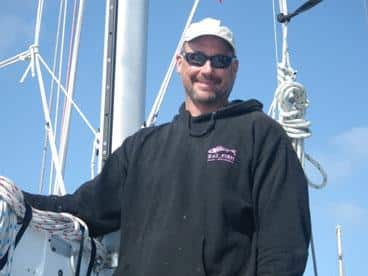
Left: Tim Sell
Tim’s the one who should’ve been racking up the calories, for he burns plenty of them as a diver and outrigger canoeist. He’s also a photographer, has worked as a carpenter in Alaska, races his Coronado 25 and a Wiley 30, and is preparing Lucky Star, the 36-foot Brent Swain steel boat he lives aboard in the anchorage, for passage to Hawai’i. “I’ll use Hawai’i as a jumping-off point for the Pacific,” he says. “There’s also a canoe race I want to enter there. My plan is to go back and forth so I can balance my cruising with my job.”
Besides cleaning hulls, Tim also helps rebuild moorings, conduct salvage operations, and execute waterfront construction projects for Dave’s Diving Service, a local business. “It’s gnarly working in winter as a diver,” he says. “It’s amazing what people will ask you to do.”
As for the condition of hulls, he reports that “it varies. I do raceboats that you can hardly see the growth on. Some of it’s pretty nasty, but some of it’s pretty light,” he says. “Ongoing maintenance and inspections are other parts of our work.”
The job helps him achieve his goals. “Diving is where I make my money,” he explains. “I also help friends with projects, as a way to help my community. People here are so diverse. They’re sailors and artists. This is a tremendous place to refit or build a cruising boat. There’s a good network of trades people and gear. I love my friends here. They’ve helped me with my dream.”
John “Woody” Skoriak, delivery skipper, freelance writer, and yacht broker, also appreciates the surroundings he’s adopted for nearly two decades. “Sausalito is an entity unto itself,” he says. “There’s no place in the world where you can have such a beautiful waterfront around you without the development, as we have here. I’ve been in marinas all over the world and have never seen one without high-rises. Most marinas have shops and golf courses.”
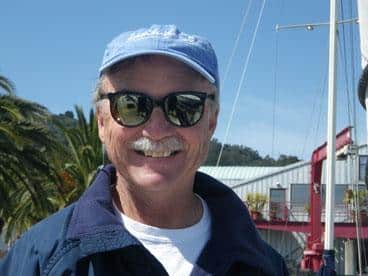
Left: John Skoriak
From the cockpit of Pacific Harbors, the Ericson 38 he lives aboard at Schoonmaker Marina, he explained how municipal planning preserved the unique character of the waterfront. “This is a very unusual place,” he says, adding that zoning limits activity exclusively to marine and arts-related businesses.
Those factors, plus proximity to San Francisco and the lush Napa Valley wine region, contribute to its enduring appeal. “It’s a great place to live in and to come and go from,” John says. “It’s the normal state of affairs to be coming and going from Sausalito. What other people dream about is normal here.”
Tom Zinn, who’d returned last November after spending several years in Austin, Texas, enthusiastically echoes the sentiment. He’s settled back in, this time, in a slip at Sausalito Yacht Harbor, where he’s doing a minor refit aboard Walk the Line, his Beneteau First 405. He and a friend sailed the boat from Southern California. “We’d done a straight shot from Morro Bay, and when we got here, half of the people are the ones I knew years ago, in the 1990s,” he says. “Not a lot has changed.”
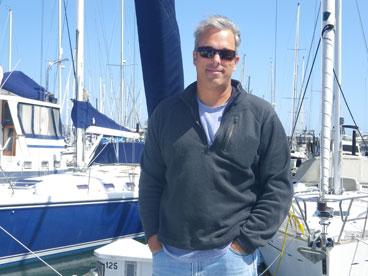
Left: Tom Zinn
The boat’s name gives a hint to Tom’s livelihood and life. A professional photographer with a background in computer software, he’s shot Grand Prix racing events, including the America’s Cup. He’s also worked in the commercial music industry, taking cover photos of bands and singers. He was listening to the radio shortly after he bought the Beneteau in San Diego, and when the famous Johnny Cash song came on, he started reflecting on life and a marriage that had recently ended. He thought: That’s the perfect name for my boat.
Now, when he’s not sailing in Northern California, he keeps busy working on the boat and looking for photographic subjects. Tom hopes that when the 34th America’s Cup comes to San Francisco in 2013, his well-established skills at photographing the unpredictable drama on the water will help him land a gig.
Lunchtime rolled around pretty quickly. Since it’s always easy to find hungry sailors, I latched on to Rob Tryon and his better half, the Lat 38-acclaimed LaDonna, for a delectable, sustainably caught feast at the popular Fish restaurant.
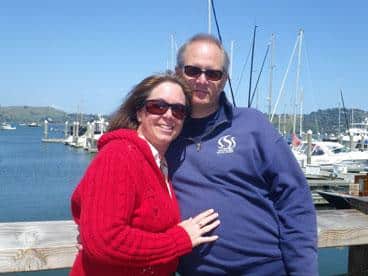
Left: LaDonna Bubak and Rob Tryon
This duo doesn’t just live aboard Silent Sun, a William Crealock-designed Pacific Seacraft 37. Rob and LaDonna are each accomplished sailors and singlehanders in their own right. For years LaDonna soloed Salacia, a Catalina 27, on the Columbia River out of Portland, Oregon; Rob’s a veteran of the 2008 Singlehanded TransPacific Yacht Race, and he served as race co-chair in 2010.
Rob did the race aboard a Robert H. Perry-designed Valiant 32. “The boat was a little slow, but it was a lot of fun,” he says. “LaDonna got people to write me notes and told me I could open the box at the halfway point. I was a little down. Then I opened the box and there were notes from John and Amanda Neal, Lin and Larry Pardey, sailing writer Herb McCormick, and_ Lat 38_ publisher Richard Spindler, who included $40 and told me to buy a burger when the race was over. There it was—personal notes from my heroes.”
That certainly supplied the needed push to help him complete the race, which he did in 19 days.
Did he buy the burger?
“I did buy the burger, at Bubba’s, from a girl in a bikini who had no tan lines,” Rob clearly recalls.
While he mulls over doing another Singlehanded TransPac someday, LaDonna lends perspective. “It’s an addictive race,” she says. “Everybody says they won’t do it again, and then they do.”
At nearby Richardson Bay Marina, Adam Correa personifies that notion, and then some. Adam, a surfer and sailor, has bought and sold nearly a dozen boats, knocked off the Singlehanded TransPac 2010 in Blue Moon, an International Folkboat, and is contemplating doing another.
Yet these milestones pale in comparison to another. For a few years now, Adam’s convinced his girlfriend, Kathe Hashimoto, a fulltime photographer for the Gap, to abandon her landlubberly ways. The couple lives aboard his-and-her boats in neighboring slips.
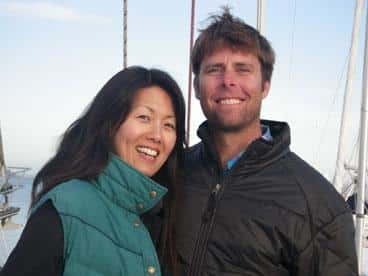
Left: Hashimoto and Correa
“We were living in a studio apartment in a houseboat,” Kathe says over tea. “We were paying $1,000 a month for 300 square feet. Adam started to get the idea that we could live aboard the 26-foot boat he then owned. We’d be nose to nose, I told him. I said, ‘There’s no way I’m going to live on a boat!’”
To which Adam had the perfect rejoinder. On Craigslist he found Seahound, a 27-foot Cal T/2 that had “one or two keel-bolt issues, as in missing one or two,” Adam says. The rest is romantic history, for today Adam sets up house aboard Domino, a Wilderness 30, Kathe keeps her kit aboard the Cal, and they “commute” to and fro. In the winter of 2011, she sealed a deal on a Santana 30 to stoke her sailing fires.
“For me, it was checking out a lifestyle I’d never been privy to,” Kathe says. “I like everything just so. Adam likes to live in a very spartan fashion. We’ve got nearly 60 feet of waterline. Besides, Adam wants to do singlehanded races, and this way I won’t have to camp in the car.”
Besides helping the couple hone sailing skills, the other silver lining to the liveaboard life is that it’s good for the budget’s bottom line. Seahound cost $5, and in giving up apartments in San Francisco and in a houseboat, Kathe’s paid off $35,000 in debt. “I downgraded from apartments to a sailboat, but I’ve taken a step up in my career,” she says.
A dinner invitation was calling, so I bid this lively young couple farewell. I reflected over the adventures of all the liveaboards I met as I made my way back into the hills, to an Italian restaurant that contained its own olive oil press and a banquet room where a reception for instructors of expressive dance was the post-dinner entertainment. Clearly, I wasn’t in Sausalito anymore.
Elaine Lembo is CW’s deputy editor.







